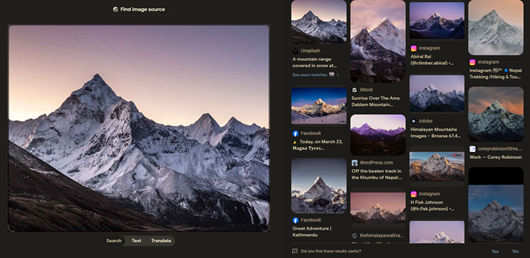
What Can You Learn More About an Image With a Reverse Image Search?
Reverse image search is a phenomenon where you conduct a web search with an image instead of keywords. This is also known as visual search.
With the advent of machine learning and OCR, search engines are now capable of processing images more discreetly. Gone are the days when an image was classified by its tags and alt text.
Now, a machine can look at an image and classify it according to a number of different parameters such as art style and entities found in the image. Today, we are going to check out what kinds of things you can learn from a reverse image search.
Things You Can Learn from Reverse Image Search
If you do an image search, you can find the following information (depending on the image).
1. Image Source and Variants
When you do an image search on a search engine like Google or Bing, you will be shown the results that include the source of the image. The only way for search engines to know that is by checking the date on which the first image was published.
So, they will show the source of an image. In the case of art and artists, they will also show the creator of the original image. This is great for when you want to give credit for using someone’s image but do not know who the creator is.
A reverse image search will also show variants of the image you searched. This includes the same image in different sizes and colors. You can use this feature when you don’t want to resize an image yourself.
The variants can also include other images with similar features. For example, if you are searching with a picture of a mountain, the variants may include pictures of the same thing from a different angle or time of the day.

As you can see, the images include pictures of the mountain in different weather and time of day. There are also some edited and processed images in the mix as well. So, reverse image search is great for finding different variants of a picture.
2. Identification of Landmarks Or Objects in an Image
Reverse image searches can also identify landmarks, objects, and locations in an image. A great example of this is the Google Lens app. You can use this app to take a picture of, say, a plant and it will do a reverse image search to find the name of that plant as well as all other supplementary information.
Of course, plants are just one object. You can use reverse image search to identify any object, be it an instrument, a tool, or even a weird nut/bolt. Here is an image showing this feature in action.

In the picture, you can see that the fork was focused on, so all the reverse image search results are showing forks only. The rest of the image was ignored.
The same feature can help you find out the location where a picture was taken by doing a reverse image search. Machine learning is used to identify any landmarks in the picture, and then it uses that information to cross-reference with its database and give you an accurate idea of where the picture was taken.
3. Keywords Related to the Image
Some search engines will provide keywords in the search results for the image you searched. These are keywords that can be used to reach the image you have searched. Take a look at the given image. We used the image of a computer power supply unit to do a reverse image search.

As you can see, it is possible to glean some keywords from the “Related Searches” section.
This has a few possible uses, such as the ones given below.
- Optimizing keywords to get your images to appear in more searches.
- Learning which search terms people are using to find similar images.
- If you are selling a product, then you can even learn about competitors, too.
A savvy marketer can use this information wisely to improve their own marketing tactics and optimize images (i.e., updating metadata and alt text). This can help them get more traffic and leads from a new source of organic traffic since image searching is different from normal text-based searching.
Conclusion
And there you have it. We covered three major types of information that you can obtain about an image by doing a reverse image search. You can find its source on the internet. You can find other variants of it. Also, can find similar images to it.
You can also identify individual entities inside an image using reverse image search. You can also learn SEO-related information, such as keywords for which the image ranks.
All of that information in the right hands can make a world of difference. So, don’t sleep on reverse image search.






